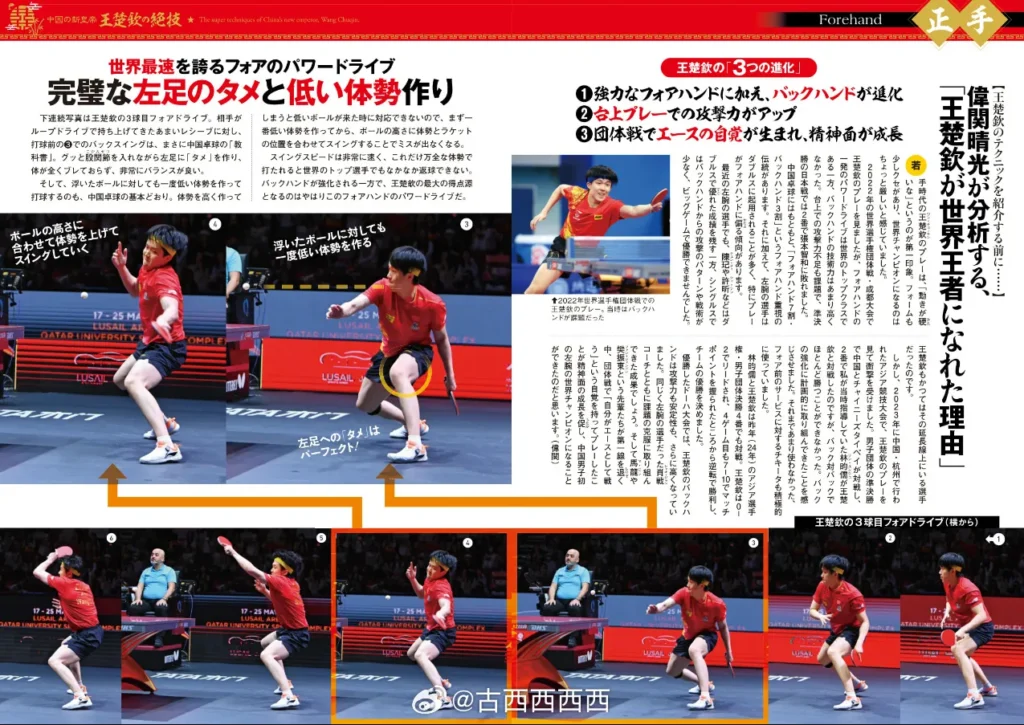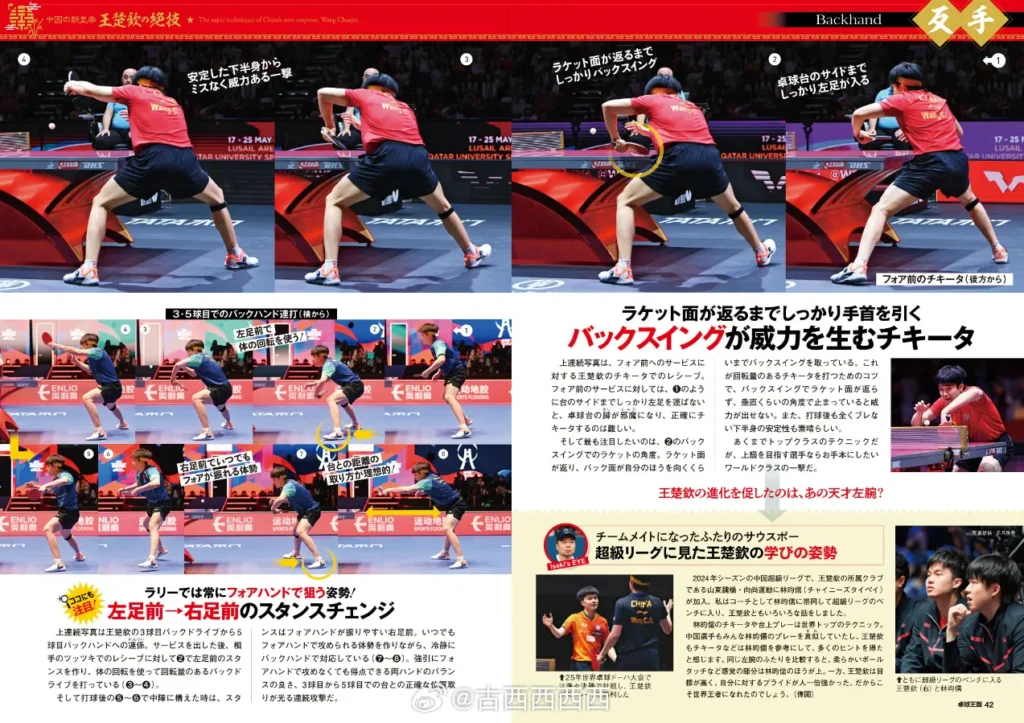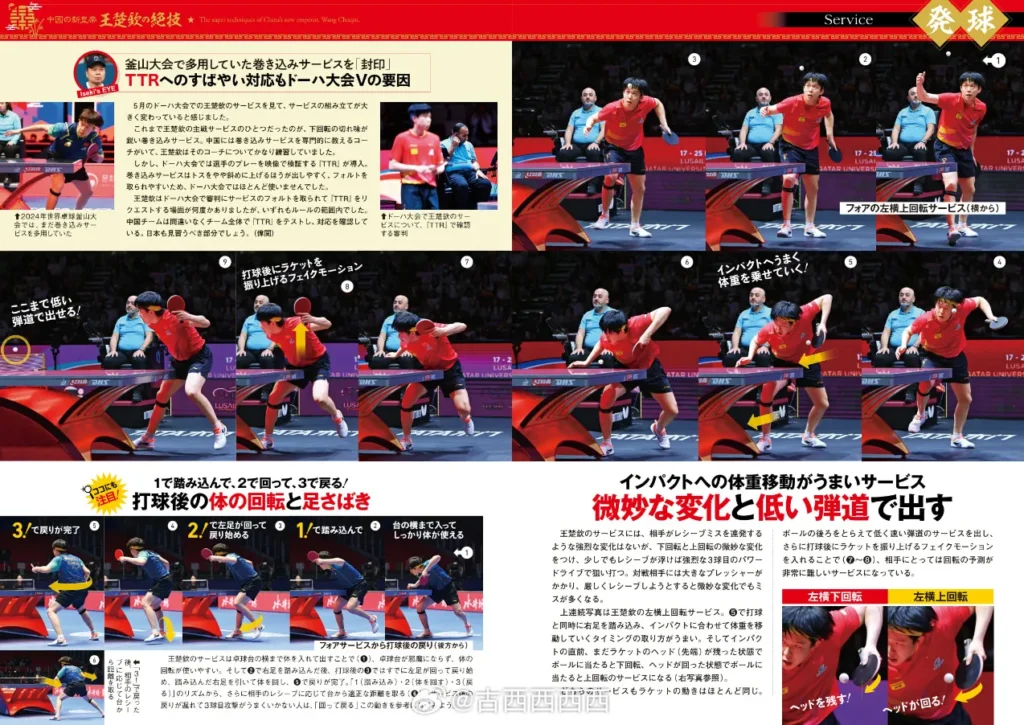At the World Championships in Doha, China’s Wang Chuqin won his first men’s singles title. He not only plays with explosive power, but has also grown increasingly mature, winning the crown not just through attacking force, but with a well-rounded, all-around game.


The Three Evolutions of Wang Chuqin
Before breaking down Wang Chuqin’s techniques… Coach Wei Qingguang analyzes “Why Wang Chuqin Became World Champion.”
❶ Alongside his powerful forehand attack, his backhand has made a huge leap forward.
❷ His over-the-table attacking skills have become sharper.
❸ With the awareness of being the ace in team events, his mental game has matured.
In his early years, Wang Chuqin’s game gave me the impression that it was “a bit stiff.” His stroke form had some quirks, and I thought it would be difficult for him to become a world champion.
At the 2022 World Team Championships in Chengdu, I saw him play again. Wang’s forehand power-drive was already world-class, but his backhand was less impressive. The lack of attacking strength in over-the-table situations was also an issue. In the team semifinal against Japan, he lost his match to Tomokazu Harimoto.
Chinese table tennis has a long-standing tradition of “70% forehand, 30% backhand”, emphasizing forehand dominance. Left-handers are often placed in doubles, which makes their play even more forehand-oriented. Even former left-handers such as Chen Qi and Xu Xin achieved excellent doubles results, but their limited tactical patterns starting from the backhand in singles kept them from winning major singles titles.
Wang Chuqin used to follow that same path.
However, at the 2023 Asian Games in Hangzhou, I was genuinely stunned by his play. In the men’s team semifinal between China and Chinese Taipei, Wang faced Lin Yun-Ju, whom I was coaching at the time. In backhand-to-backhand rallies, Lin could hardly win a point. It was clear Wang had systematically strengthened his backhand. He was also actively using the banana-flick receive against short serves to his forehand, something he had rarely done before.
The two met again in the 2024 Asian Championships men’s team final. Down 0-2 in games and facing match points at 7-10 in the fourth, Wang came back to win, securing the victory for Team China.
At the Doha World Championships, where Wang Chuqin lifted the singles trophy, his backhand had gained both greater attacking power and more stability. This was likely the result of working with coach Xiao Zhan, himself a left-hander, to address his weaknesses. And with veterans Ma Long and Fan Zhendong stepping back from the front line, Wang’s awareness of “I will play as the ace” in team events fostered his mental growth. This helped him become the first left-handed men’s singles world champion in Chinese table tennis history.
Forehand:
The World’s Fastest and Most Lethal Scoring Weapon
World’s Fastest Forehand Power Drive,
Perfect Left-Leg Load and Low Stance Preparation
The photo sequence below shows Wang Chuqin’s forehand third-ball attack. Against a weak return from his opponent’s loop drive, his backswing before contact (Picture ③) is straight out of the Chinese table tennis “textbook.” He sinks through the hip joint to create a solid load on his left leg and keeps his body completely steady with excellent balance.
Even against a lob, Wang first drops into a low stance before making the shot, exactly as taught in Chinese table tennis fundamentals. If your initial stance is too high, you cannot handle a low incoming ball. By first creating the lowest stance and then adjusting both body and racket position to match the ball’s height, he minimizes errors.
Wang’s swing speed is exceptionally fast. When he strikes from such a perfect position, even the world’s top players struggle to return the ball. While the backhand has improved greatly, his most dangerous scoring weapon remains his forehand power drive.

Backhand:
Fully Committed Backswing, Now World-class
Pulling the Wrist Back Fully Before the Racket Face Closes,
A Backswing that Generates a Powerful Banana Flick
The photo sequence above shows Wang Chuqin receiving with a banana flick against a short serve to his forehand.
Against a serve to the forehand side (①), the left foot must step fully out toward the side of the table. Without doing so, the table leg will obstruct movement, making it difficult to execute an accurate flick.
The key detail is the racket angle during the backswing (②). Wang pulls the racket back until its backhand side is almost facing himself. This is crucial for producing a banana flick with heavy spin. If the racket face remains nearly vertical and does not turn over in the backswing, the shot loses both power and spin. His lower-body stability after contact, with absolutely no wobble, is also outstanding.
This is a top-class technique. For any advanced player aiming to improve, it is a world-class shot worth studying.
Always Positioning to Attack with the Forehand in Rallies,
Switching Stance from Left-Foot-Forward to Right-Foot-Forward
The sequence above shows Wang Chuqin’s transition from a third-ball backhand drive to a fifth-ball backhand attack. After serving, he receives a push return from his opponent. He sets a left-foot-forward stance and uses body rotation (②) to produce a heavy-spin backhand drive (③-④).
After the shot, Wang moves to mid-distance, his stance shifts to right-foot-forward, making it easier to unleash the forehand (⑤-⑥). By maintaining a position where he can attack at any time with the forehand while still handling the rally calmly with the backhand (⑦-⑧), he shows excellent balance between forehand and backhand. His ability to score without forcing a forehand attack, combined with precise positioning from the third to the fifth ball, stands out in this continuous attacking sequence.
Was Wang Chuqin’s Evolution Inspired by Another Left-Handed Player? Two Left-Handers as Teammates – Learning in the Chinese Super League
In the 2024 season of the Chinese Super League, Lin Yun-Ju of Chinese Taipei joined Wang Chuqin’s club, Shandong Weiqiao Xiangshang Sports. I accompanied Lin as his coach, sitting on the bench throughout the season, and had many conversations with Wang.
Lin’s banana flick and over-the-table play are among the best in the world. Many Chinese players have studied his style, and I felt Wang also drew inspiration from Lin’s flicks. Comparing the two left-handers, Lin has the edge in soft touch and feel for the ball, while Wang has higher ambitions and a stronger pride in himself. That is likely one of the reasons he became world champion.

Serve: Delicate Variations, Weight transfer, Low trajectory
Putting Away the Pendulum Serve He Used Frequently in Busan,
Quick Adaptation to TTR Was Key to His Doha Victory
Watching Wang Chuqin’s serves at the Doha WTTC in May, I noticed his serve patterns had changed considerably.
In the past, one of his main serves was a pendulum serve with extremely sharp backspin. In China, there are coaches who specialize in the pendulum serve, and Wang had spent significant training time under such a coach.
However, at the Doha WTTC, the TTR system—using video to review players’ serves—was introduced. The pendulum serve is easier to execute with a slightly angled toss, which is more likely to be faulted, so Wang barely used it in Doha.
Several times, Wang was called on serve and requested a TTR review. In every case, the review confirmed he was within the rules. It’s clear that the Chinese national team had tested TTR thoroughly and prepared their responses. This is something Team Japan should also take note of.
Smooth Weight Transfer Into Contact Subtle,
Variation and Low-Trajectory Serves
Wang Chuqin’s serves do not rely on extreme spin variations to force repeated receive errors from his opponents. Instead, he uses subtle changes between backspin and topspin. If the return pops up slightly, he punishes it with a powerful third-ball forehand drive. This puts the opponent under heavy pressure, and when they try to receive more precisely, even these subtle variations can cause mistakes.
The photo sequence above shows Wang’s left-sidespin topspin serve. He steps in with his right foot at the moment of striking (⑤), timing the weight transfer perfectly. Just before contact, if the racket head (tip) is still lagging behind, the serve becomes underspin; if the head has already come through, it becomes topspin (see photo on the right).
To produce these two types of serve, Wang’s racket motion appears almost identical. By brushing the back of the ball, he creates a low, fast trajectory; by adding a fake upward swing (⑦-⑧), he makes the spin extremely difficult to read.
Step in on 1, Rotate on 2, Return on 3,
Body Rotation and Footwork After Shot
When serving, Wang positions his body fully to the side of the table (①), avoiding obstruction and allowing fuller body rotation. After serving while stepping in with his right foot (②), his left foot has already returned to its regular position. He then pulls back the stepped-in right foot, turning his body back (⑤).
This “1 (step in) – 2 (rotate) – 3 (return)” rhythm lets Wang adjust his distance from the table according to the opponent’s receive (⑥). For players whose third-ball attacks break down because of slow recovery, this “rotate and return” motion is worth studying.

Tactics: Relentless Straight-line Rally, Lock Down, and Restrict Opponents
Neutralizing Moregard’s Strengths,
Straight-Line Attacks with Both Wings
The photo sequence above is from the men’s singles semifinal against Sweden’s Truls Moregard at the Doha WTTC. Against Moregard, who has a wide range of backhand techniques, Wang Chuqin first played a drop shot to the middle (②-③) to draw him in close, then followed with a sharp down-the-line angle on the fourth-ball backhand drive (⑥-⑧).
Although caught slightly off guard, Moregard returned with a backhand block loaded with right sidespin (⑨). Facing a ball curving into his forehand, Wang let it drop slightly and still attacked down the line with a heavy-spin forehand drive (⑪-⑫), forcing the error from Moregard.
When left-handers face right-handers, straight-line attacks are a key pattern because they are harder for the opponent to react to and often draw the next ball crosscourt. Moreover, against a player like Moregard, who is strong on the backhand side and dangerous with counter backhand pushes, Wang sent heavy-spin balls to his forehand side to limit his options. Wang sent heavy-spin balls to his forehand side to limit his options. This was a brilliant tactic to shut Moregard down, executed at 10-10 in the fourth game, a crucial point in the match.
Improved Backhand Stability Brings More Consistent Results,
Still Room for Growth in Over-the-Table Attacking
In the past, Wang Chuqin sometimes suffered unexpected losses in tournaments. With greater stability in his backhand-based techniques, he now controls matches not only with power but also with spin, producing more consistent results. In the Chinese men’s team, Lin Shidong is a promising talent but still young, so Wang’s era is likely to continue for a while.
In mid- and long-distance rallies, his attacking ability is unquestionably among the best in the world. However, compared to his other skills, there is still room for further development in his over-the-table attacking power.
Wang has also achieved excellent results in doubles, but at the Paris Olympics, he may have spent too much energy early on playing mixed doubles with Sun Yingsha, leaving less in reserve for singles. This might be the fate of left-handers, but if he wants to stand on top of the singles podium at the 2028 Los Angeles Olympics, managing his energy balance between doubles and singles will be crucial.
Source: 古西西西西 – 微博
Read Also
2025 WTTC Doha: Calm After the Climb 👑
Chuqin’s 2025 World Cup: A Fight, Not a Fall
Wang Chuqin vs. Systemic Bias Against Left-Handers in Chinese Table Tennis
Wang Chuqin and the Mystery of China’s Coaching System Neglect
Leave a Reply